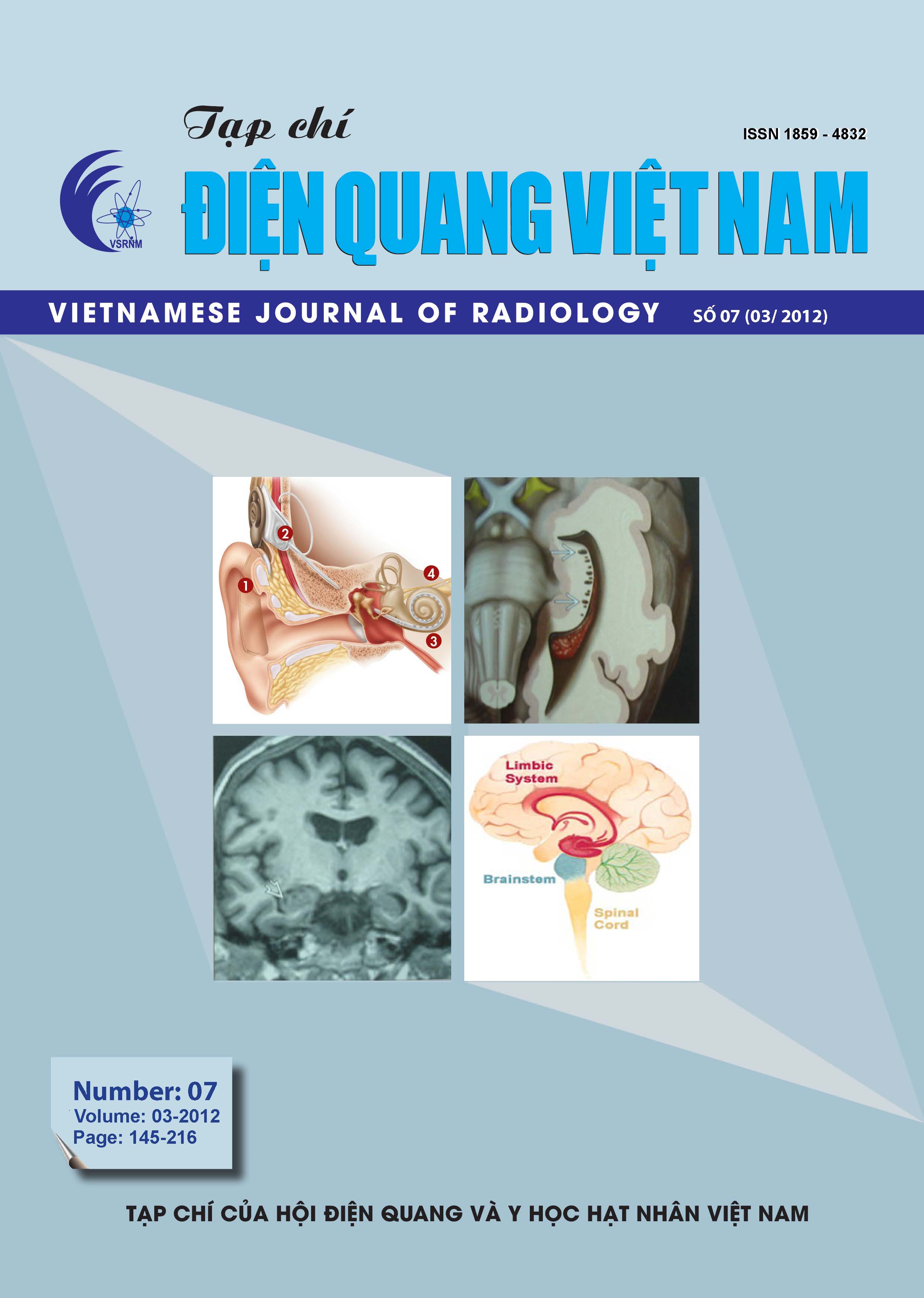TƯƠNG QUAN CAO VỀ MỨC ĐỘ HẤP THU 2-DEOXY-2-F18-FUORO-D-GLUCOSE (FDG) QUA TRUNG GIAN GLUCOSE TRANSPORTER TYPE 1 (GLUT-1) GIỮA KHỐI U NGUYÊN PHÁT VÀ HẠCH DI CĂN TẠI CHỖ TẠI VÙNG TRONG UNG THƯ PHỔI KHÔNG TẾ BÀO NHỎ
Nội dung chính của bài viết
Tóm tắt
TÓM TẮT
Mục tiêu: Khảo sát tương quan giữa mức độ hấp thu 2-deoxy-2-F18-fluoro-D-glucose (FDG) qua trung gian glucose transporter type 1 (Glut-1) của khối u nguyên phát và hạch di căn tại chỗ tại vùng trong ung thư phổi không tế bào nhỏ.
Đối tượng: 126 bệnh nhân ung thư phổi không tế bào nhỏ (Nam:Nữ = 103:23, tuổi = 65 ± 9,7) có chụp FDG-PET trải qua phẫu thuật cắt bỏ khối u và nạo hạch tại chỗ tại vùng từ tháng 08/2003 đến 07/2006.
Phương pháp: Giá trị hấp thu chuẩn tối đa (maxSUV) trên hình ảnh PET và biểu hiện Glut-1 trên kết quả hóa mô miễn dịch của khối u nguyên phát và hạch di căn tại chỗ tại vùng được so sánh.
Kết quả: Tương quan ý nghĩa đã được tìm thấy giữa hạch di căn và khối u nguyên phát về mức độ hấp thu maxSUV (r = 0,6451, p < 0,0001), mức độ biểu hiện %Glut-1 (r = 0,8341, p < 0,0001) và cường độ bắt màu Glut-1 (p = 0,827, p < 0,0001). Khi mức độ hấp thu FDG của khối u nguyên phát maxSUV >6, giá trị vùng dưới đường cong để phân biệt hạch di căn tại chỗ tại vùng với hạch lành tính là cao có ý nghĩa (AUC = 0,775, p = 0,0001).
Kết luận: Tương quan cao mức độ hấp thu FDG qua trung gian Glut-1 giữa khối u nguyên phát và hạch di căn tại chỗ tại vùng có lẽ hữu ích trong việc sử dụng hình ảnh PET để phân biệt hạch di căn tại chỗ tại vùng với hạch lành tính trong ung thư phổi không tế bào nhỏ
Chi tiết bài viết
Từ khóa
Ung thư phổi không tế bào nhỏ, FDG-PET, hạch, Glucose transporter
Tài liệu tham khảo
1. Vansteenkiste JF, Stroobants SG, De Leyn PR, et al. Mediastinal lymph node staging with FDG-PET scan in patients with potentially operable non-small cell lung cancer: a prospective analysis of 50 cases. Leuven Lung Cancer Group. Chest 1997;112 :1480–6.
2. Lardinois D, Weder W, Hany TF, et al. Staging of non-small-cell lung cancer with integrated positron-emission tomography and computed tomography. N Engl J Med 2003; 348 :2500–7.
3. Higashi K, Ueda Y, Sakurai A, et al. Correlation of Glut-1 glucose transporter expression with [18F]FDG uptake in non-small cell lung cancer. Eur J Nucl Med 2000;27 :1778–85.
4. Chung JK, Lee YJ, Kim SK, Jeong JM, Lee DS, Lee MC. Comparison of [18F]fluorodeoxyglucose uptake with glucose transporter-1 expression and proliferation rate in human glioma and non-small-cell lung cancer. Nucl Med Commun 2004; 25:11–7.
5. Mamede M, Hig ashi T, Kitaichi M, et al. [18F]FDG uptake and PCNA, Glut-1, and hexokinase-II expressions in cancer s and inflammatory lesions of the lung. Neoplasia 2005; 7:369–79.
6. Higashi K, Ueda Y, Ayabe K, et al. FD G PET in the evaluation of the aggressiveness of pulmonary adenocarcinoma: correlation with his topatholog ical features. Nucl Med Commun 2000; 21:707–14.
7. Vansteenkiste JF, Stroobants SG, Dupont PJ, et al. Prognostic importance of the standardized uptake value on (18)F-fluoro-2-deox y-glucose-positron emission tomography scan in non-small-cell lung cancer: an analysis of 125 cases. Leuven Lung Cancer Group. J Clin Oncol 1999; 17:3201–6.
8. Higashi K, Ueda Y, Arisaka Y, et al. 18F- FDG uptake as a biologic prognostic factor for recurrence in patients with surgically resected non-small cell lung cancer. J Nucl Med 2002; 43:39–45.
9. Jeong HJ, Min JJ, Park JM, et al. Determination of the prognostic value of [(18)F]fluorodeoxyglucose uptake by using positron emission tomography in patients with non-small cell lung cancer. Nucl Med Commun 2002;23 :865–70.
10. Sasaki R, Komaki R, Macapinlac H, et al. [18F]fluorodeoxyglucose uptake by positron emission tomography predicts outcome of non-small-cell lung cancer. J Clin Oncol 2005;23 :1136–43.
11. Nguyen XC, Lee WW, Chung JH, et al. FDG uptake, glucose transporter type 1, and Ki-67 expressions in non-small-cell lung cancer: correlations and prognostic values. Eur J Radiol 2007; 62:214–9.
12. Higashi K, Ito K, Hiramatsu Y, et al. 18F-FDG uptake by primary tumor as a predictor of intratumoral lymphatic vessel invasion and lymph node involvement in non-small cell lung cancer: analysis of a multicenter study. J Nucl Med 2005; 46:267–73.
13. Cerfolio RJ, Bryant AS. Ratio of the maximum standardized uptake value on FDG-PET of the mediastina l (N2) lymph nodes to the primary tumor may be a universal predictor of nodal malignancy in patients with non-small-cell lung cancer. Ann Thorac Surg 2007;83 :1826–9 [discussion 1829-30].
14. Chung JH, Cho KJ, Lee SS, et al. Overexpression of Glut1 in lymphoid follicles correlates with false-positive (18)F-FDG PET results in lung cancer staging. J Nucl Med 2004; 45 :999–1003.
15. Chung JH, Lee WW, Park SY, et al. FDG uptake and glucose transporter type 1 expression in lymph nodes of non-small cell lung cancer. Eur J Surg Oncol 2006; 32:989–95.
16. Lee WW, Chung JH, Jang SJ, et al. Consideration of serum glucose levels during malignant mediastinal lymph node detection in non-small-cell lung cancer by FDG-PET. J Surg Oncol 2006;94 :607–13.
17. Song YS, Lee WW, Chung JH, Park SY, Kim YK, Kim SE. Correlation between FD G uptake and glucose transporter type 1 expression in neuroendocrine tumors of the lung. Lung Cancer 2008; in press. doi:10.1016/j.lungc an.2007.11.012.
18. Wahl R. Principles of cancer imaging with fluorodeoxyglucose. In: Wahl R, editor. Principles and practice of positron emission tomography. Philadelphia: Lippincott Williams and Wilkins; 2002. p. 100–10.
19. .
20. Mountain CF, Dresler CM. Regional lymph node classifi cation for lung cancer staging. Chest 1997;111 :1718–23.


